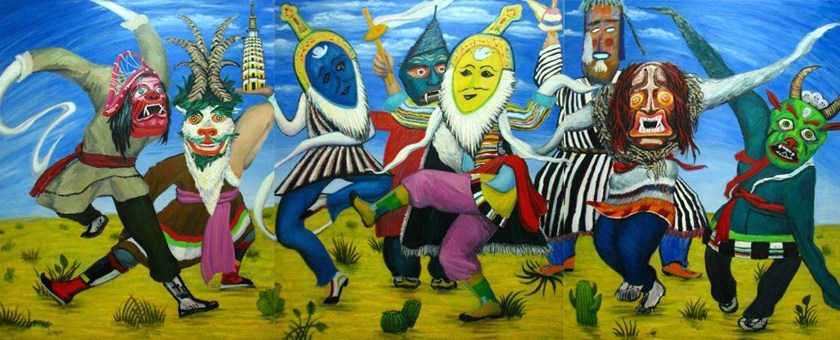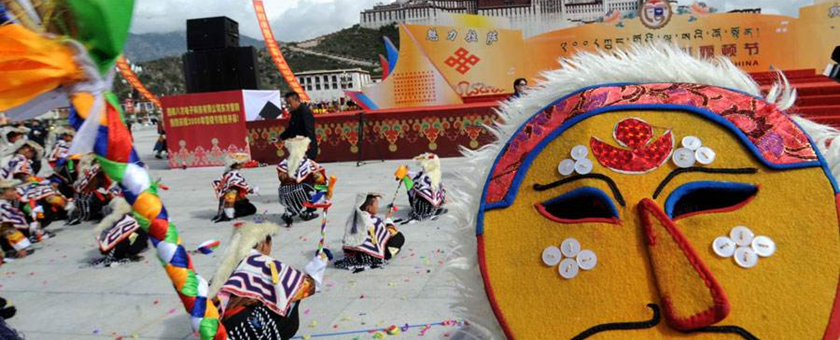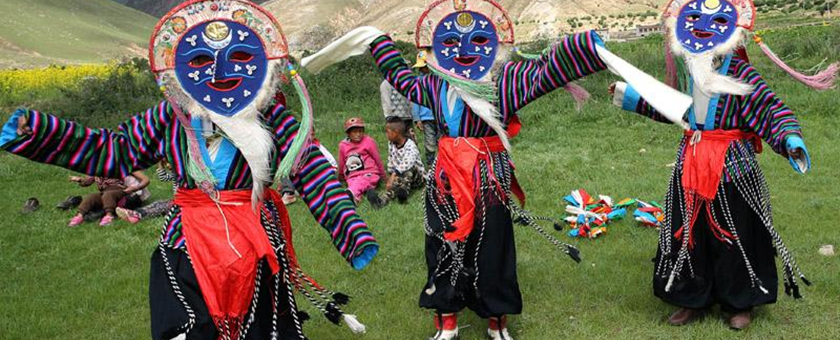info@chinaadventure.org
86-18008011324
Search
Tibetan Opera, called "Ache Lhamo" in Tibetan, which means "fairy sister". It is said that Tibetan opera was first performed by the seven sisters, and the contents of the play are mostly fairy tales in Buddhist Scriptures, hence the name. It is very popular in Tibet, especially in Shannan , Shigatse , Lhasa , and Chamdo Region. It is also widely distributed in Sichuan, Gansu, Qinghai and Yunnan Provinces. Best time for tourist to see Tibet Opera would be during Tibet Shoton Festival

History of Tibetan Opera
Tibetan Opera has a history of about 1400 years. Compared with other minority operas in China, it has the longest history. According to Tibetan historical records, King Song Zang Gambo greatly admired the Tang Dynasty costumes, music and dance introduced by the Tang Dynasty Princess Wencheng when she married the king of Tibet. He trained 16 beauties in a Tang-style art form combined with Tibetan folk music and dance to entertain the princess. Later, the entertainment developed into a more well-defined form of dance, singing, and factual performance.
During the rule of the fifth Dalai Lama in the 17th Century, the performing art was separated from religious rituals and became an independent form of drama, dominated by singing and dancing, especially the use of ornate masks. It spread from Shannan, Shigatse and Lhasa to other parts of Tibet, and further to Batang, Litang and Ganzi in Sichuan province, as well as to neighboring India and Nepal.
After continuous development and improvement, Tibetan opera has formed its own set of systematic and complete art forms since the 17th Century. It is known as a unique opera in Chinese operas, and it is widely spread in Tibetan areas and is deeply loved by Tibetans.

Characteristics of Tibetan Opera
The performance of Tibetan Opera has traditionally followed a fixed procedure, and although it has developed naturally over time, the innovation has been combined with a great deal of conservatism so as not to separate it from its ancient roots. However, certain elements of tibetan opera song seem to be immutable. For example, each grand opera began with purification and god's blessing. A special singing narrator rapidly sing a poem which summarizes part of the plot. The actors on stage perform part of the problem. This proposes a new period of narrator, followed by the performance of the actors. It's played until you reach the conclusion.The show always ends with a Hada blessing ceremony.
Costume
Tibetan Opera costumes are colorful, with a unique ethnic and highland style. For example, the Tibetan drama blue mask has images of fat waist, long sleeves, big front and bare arms. They like to decorate with animal fur, gold, silver, jewelry and other objects. Most of the clothing was based on the clothing of the Tibetan Empire. After absorbing the dress form of Yuan Dynasty and Qing Dynasty, it becomes today's dress.

Musical Score
Tibetan Opera has traditionally been played by strict sheet music with drums and cymbals, emphasizing every movement -- although this "sacred fixture" now changes, of course, through the voice of the actors. The rapid recitation of narrative fragments alternates with the singing dialogue of the performers. The accompanying dance moves from graceful fluidity to staccato to sheer acrobatics, in keeping with the unfolding of the drama.

Tibetan Opera Mask
Mask is mainly used for a variety of folk performance activities. Compared with religious masks, Tibetan Opera masks have strong secular tendencies and folk colors. The themes include historical stories and mythological characters, gods and animals. Different mask colors symbolize different characteristics, such as dark red for the king, light red for the minister, yellow for the living Buddha, blue for the villain, and half black and half white for the double-faced.
Distinguish the good, evil, loyal, treacherous character from the modelling of the mask and tonal.
Tibetan opera masks are divided into Wuba masks, character masks and animal masks.

Types of Tibetan Opera
White Mask Opera
Maternal drama is the oldest and most widely spread drama in Tibetan Opera. This is the meaning of the fairy's white mask play.
Blue Mask Opera
The most traditional, developed and influential Tibetan Opera in the central region of Tibet - the Uygur dialect opera.
In addition, there are also Khampa Opera, Ando Opera, Chamdo Opera, Jiarong Opera and Dege Opera in Tibet.

Tibetan Plays
Tibetan Opera tradition play legend has "Thirteen Ben", often is "Princess Wencheng", "Nuo Shang King", "Lang Sa Girl", "Zhuo Ma Sam", "Su Ji Ni Ma", "Bai Ma Wen Ba", "Dun Zhu Dun Yue" "Zhimei Gengden" and so on "the Eight Tibetan Opera".

we’ll reply you in 24 hours!
Copyright © 2012-2024 All Rights Reserved to chinaadventure.org